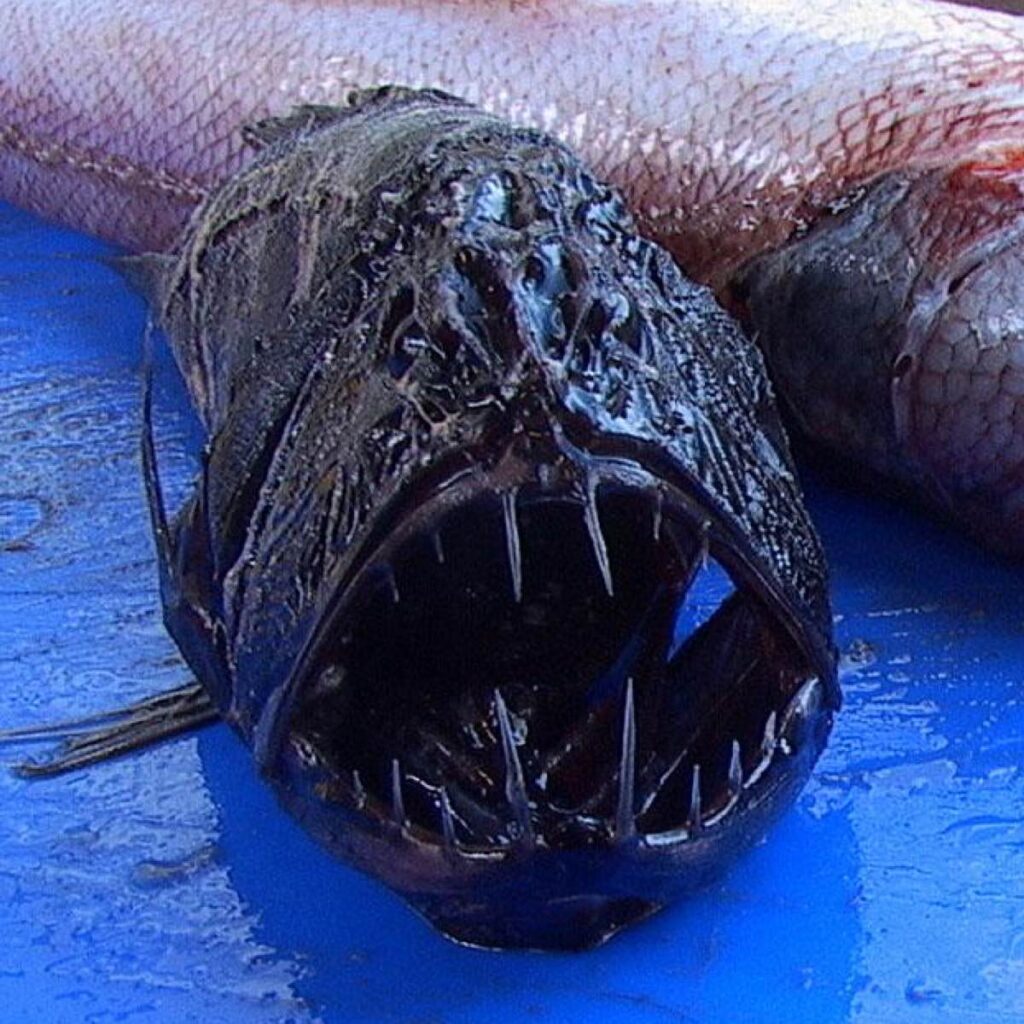Last Reviewed and Updated on February 26, 2023
Fangtooth fish, with their fearsome appearance and especially their long teeth, are one of the most intriguing and mysterious creatures that inhabit the depths of the ocean. Learn some facts about the fangtooth fish that will shed light on some of their most interesting and distinctive characteristics.

About Fangtooth Fish
Fangtooth fish are deep-sea fish that belong to the family Anoplogastridae. They are found in oceans around the world, typically at depths of 660 and 6,560 ft / 200 and 2,000 m.
There are currently two recognized species of fangtooth;
- shorthorn fangtooth (Anoplogaster brachycera)
- common famgtooth (Anoplogaster cornuta)
One of the most distinctive features of fangtooth fish are their large, sharp teeth. Common fangtooth fish are usually up to about 6.3 inches (16 cm) in length, and the shorthorn fangtooth is usually half that size.
Fangtooth fish are dark brown or black in color, and their bodies are compressed and elongated with a large head. Their body is progressively more slender towards the tail.
They are carnivorous and feed on a variety of deep-sea creatures, including other fish, squid, and crustaceans.
Despite their ferocious appearance and sharp teeth, fangtooth fish are not a threat to humans. Commercial fisheries do not typically catch them due to their deep-sea habitat, so their impact on human populations is minimal.
Interesting facts about fangtooth
From their specialized teeth sockets to their sturdy bodies, we will uncover some fascinating facts about fangtooth fish.

If you love unique-looking animals, be sure to check our list of strangest creatures in the world or our list of 100 weird animal facts.
Love learning about fish? Read our extensive list of unique fish facts.
1. They have the largest teeth in proportion to the body size of any marine fish
Fangtooth is considered to have the largest teeth-to-body ratio in marine fish. This deep-sea fish has long, needle-like teeth that are proportionally very large compared to its small body size: they can be about a third of their body in length (refference: Dental structure and tooth attachment modes in the common fangtooth Anoplogaster cornuta).
Fun fact: a marine animal with the largest tooth-to-body ratio, if we include modified teeth like tusks, is the narwhal, whose tusk can reach about half its body length.
2. Adults aren’t able to completely close their jaw
Adult fangtooth have really long fangs; in fact, the fangs prevent the adult fish from being able to completely close their mouth (source).
3. They evolved special sockets for their teeth
Their two large fangs on the lower jaw are so long that these fish evolved a pair of sockets on the top side to accommodate the teeth when their mouths are closed.
4. Juveniles and adults were once considered to be different species
The juvenile fangtooth has a different appearance from adult fangtooths. In the 1800s, scientists have thought that juvenile fangtooths were a different species than adults because of their physical and behavioral differences.
Unlike adults, juvenile fang-tooth display larger eyes and small teeth. They don’t typically inhabit the same depths either, with juveniles living in lower depths.
Their diet also differs, as juveniles feed on crustaceans, and adults mainly feed on fish and shrimp (source).
5. Fangtooth is believed to have poor vision
They have small eyes and rely on their highly developed lateral line, a system of sensory organs that detect movement and other changes in the surrounding water.
6. They are amongst the deepest living fish
While they are most common at depths between 660 and 6,560 ft / 200 and 2,000 m, these fish have also been spotted at depths as far as 16,000 ft / 5 km.
7. Fangtooth is very sturdy for a deep sea fish
Many other deep-sea fish lose their shape or can’t properly function when they are brought to shallow waters or aquariums. This is due to their adaptations to the high pressures of their deep-sea environment. The fangtooth has been kept alive for months in an aquarium.
